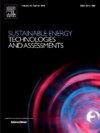A comprehensive review in pursuit of optimal solar performance: Nanofluids, solar hybrid systems, and challenges ahead
IF 7.1
2区 工程技术
Q1 ENERGY & FUELS
Sustainable Energy Technologies and Assessments
Pub Date : 2025-06-28
DOI:10.1016/j.seta.2025.104420
引用次数: 0
Abstract
Enhancing energy efficiency and advancing sustainable energy solutions remain critical for mitigating global challenges such as climate change, water pollution, and air pollution. Solar energy contributes significantly to resolving these issues. However, its intermittent nature poses limitations for standalone applications. This review addresses these challenges by evaluating two key strategies: enhancing heat transfer in solar systems using mono and hybrid nanofluids, and integrating solar technologies with other energy sources to form hybrid systems. These approaches not only boost solar system efficiency but also ensure grid stability under fluctuating environmental conditions. The paper reviews recent advancements in nanofluid applications across various solar configurations, including flat plate, vacuum tube, parabolic trough, and photovoltaic thermal systems. Additionally, it explores hybridisation techniques combining solar with fossil fuels and renewable sources such as biofuels, wind, geothermal, and hydro energy to improve system stability and scalability. The review outlines the advantages, disadvantages, and challenges of using nanofluids in solar hybrid systems, while also highlighting key performance outcomes such as improved thermal efficiency and reduced CO2 emissions, and discussing practical design considerations, technical limitations, and environmental benefits. This study aims to inform future research and support the implementation of efficient and sustainable hybrid solar energy systems.
在追求最佳太阳能性能的综合综述:纳米流体,太阳能混合系统,以及未来的挑战
提高能源效率和推进可持续能源解决方案对于缓解气候变化、水污染和空气污染等全球挑战仍然至关重要。太阳能为解决这些问题作出了重大贡献。然而,它的间歇性给独立应用程序带来了限制。本文通过评估两种关键策略来解决这些挑战:利用单一和混合纳米流体增强太阳能系统的传热,以及将太阳能技术与其他能源相结合形成混合系统。这些方法不仅提高了太阳能系统的效率,而且确保了电网在波动环境条件下的稳定性。本文综述了纳米流体在各种太阳能结构中应用的最新进展,包括平板、真空管、抛物槽和光伏热系统。此外,它还探索了将太阳能与化石燃料和可再生能源(如生物燃料、风能、地热能和水能)相结合的混合技术,以提高系统的稳定性和可扩展性。这篇综述概述了在太阳能混合动力系统中使用纳米流体的优点、缺点和挑战,同时也强调了关键的性能结果,如提高热效率和减少二氧化碳排放,并讨论了实际设计考虑、技术限制和环境效益。这项研究旨在为未来的研究提供信息,并支持高效和可持续的混合太阳能系统的实施。
本文章由计算机程序翻译,如有差异,请以英文原文为准。
求助全文
约1分钟内获得全文
求助全文
来源期刊

Sustainable Energy Technologies and Assessments
Energy-Renewable Energy, Sustainability and the Environment
CiteScore
12.70
自引率
12.50%
发文量
1091
期刊介绍:
Encouraging a transition to a sustainable energy future is imperative for our world. Technologies that enable this shift in various sectors like transportation, heating, and power systems are of utmost importance. Sustainable Energy Technologies and Assessments welcomes papers focusing on a range of aspects and levels of technological advancements in energy generation and utilization. The aim is to reduce the negative environmental impact associated with energy production and consumption, spanning from laboratory experiments to real-world applications in the commercial sector.
 求助内容:
求助内容: 应助结果提醒方式:
应助结果提醒方式:


